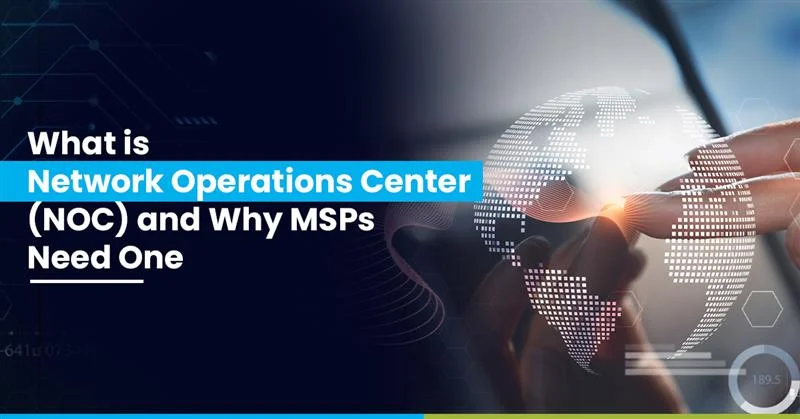Network operations center solutions are transforming how MSPs deliver client services. The days of reactive IT support are officially over.
Enterprise downtime costs exceed $300,000 per hour, while small businesses lose $427 every minute their systems fail. These aren’t just numbers – they’re your clients’ biggest nightmares.
Smart MSPs leverage network operations center capabilities to prevent problems before they happen. While competitors scramble to put out fires, you’re already three steps ahead.
Here’s why every serious MSP needs a network operations center strategy now.
What is a Network Operations Center (NOC)?
Think of a network operations center as mission control for your IT infrastructure. It’s a centralized facility where trained technicians monitor, manage, and maintain your clients’ networks 24/7/365.
But here’s what makes it different from your typical help desk operation: while help desks react to problems after they happen, a network operations center prevents them from occurring in the first place.
Core Definition and Purpose of Network Operations Center
A network operations center serves as the nerve center for comprehensive network monitoring and incident response. It’s where real-time performance management meets proactive maintenance strategies.
Key functions include:
- Continuous monitoring of network devices, servers, and applications
- Immediate alert response and escalation procedures
- Performance optimization and capacity planning
- Security incident detection and initial response
- Change management and configuration control
The primary goal? Keeping your clients’ networks running smoothly while they focus on growing their businesses.
Evolution of NOC for MSPs in Modern IT Infrastructure
The concept isn’t new – AT&T pioneered the first network operations center back in the 1960s to manage their telephone infrastructure. But today’s NOC for MSPs operates in a completely different landscape.
Modern network operations center solutions integrate seamlessly with cloud platforms, hybrid environments, and complex multi-vendor ecosystems. They’ve evolved from simple monitoring stations into sophisticated command centers that leverage artificial intelligence, machine learning, and predictive analytics.
This evolution means MSPs can now offer enterprise-grade services without the enterprise-level investment traditionally required.
Major Components of a Network Operations Center
Understanding what makes a network operations center tick helps you appreciate why it’s such a game-changer for MSP operations.
A fully functional network operations center combines cutting-edge technology with human expertise to create an unbeatable monitoring and response system.
Essential Infrastructure and Technology Stack
The technology backbone of any effective network operations center includes:
Monitoring and Alert Systems:
- SNMP-based network monitoring tools
- Application performance monitoring (APM) platforms
- Infrastructure monitoring solutions
- Custom dashboard and visualization tools
Communication Infrastructure:
- Multiple communication channels for alerts
- Video conferencing capabilities for remote collaboration
- Secure messaging systems for internal coordination
- Client communication portals for transparency
Physical Infrastructure:
- Multiple large-screen displays for network visualization
- Redundant workstations with backup systems
- Uninterruptible power supplies (UPS)
- Climate-controlled environment with 24/7 access
Human Resources and Staffing Models
Technology is only half the equation. The human element makes or breaks a network operations center operation.
Staffing Levels:
- Level 1 technicians: Initial triage and basic troubleshooting
- Level 2 specialists: Advanced technical resolution
- Level 3 engineers: Complex problem solving and escalation management
- NOC managers: Process oversight and client relationship management
Coverage Requirements:
- True 24/7/365 availability (yes, including holidays)
- Shift handoff procedures to maintain continuity
- On-call escalation for critical incidents
- Regular training and certification updates
Processes and Procedures Framework
Without solid processes, even the best network operations center becomes chaotic during critical incidents.
Essential procedures include:
- Standard operating procedures (SOPs) for common issues
- Escalation matrices based on severity levels
- Change management protocols to prevent outages
- SLA monitoring and reporting mechanisms
- Incident documentation and post-mortem analysis
Why Outsourced Network Operations Center is Critical for MSPs
Here’s where things get interesting. As per Grand View Research, the global managed security services (MSS) market is projected to reach $87.5 billion by 2030, driven by MSPs leading AI-driven threat mitigation and next-gen network defense.
But here’s the challenge: almost 90% of SMBs currently use an MSP or are considering it, which means competition is fierce. How do you differentiate yourself?
Cost-Effectiveness vs. In-House NOC Development
Building your own network operations center sounds appealing until you crunch the numbers.
Initial Investment Requirements:
- Facility setup: $200,000 – $500,000
- Technology infrastructure: $300,000 – $800,000
- Staffing and training: $400,000 – $1,000,000 annually
- Ongoing operational costs: $200,000 – $500,000 per year
Compare this to outsourced network operations center solutions that typically start at $2,000 – $10,000 monthly per client, and the math becomes crystal clear.
The break-even point for an in-house network operations center usually requires managing 100+ clients with substantial monthly recurring revenue. Most MSPs reach profitability much faster by partnering with established providers.
Scalability Benefits of Outsourced Network Operations Center
Growth shouldn’t be painful, but building internal capacity often creates bottlenecks.
Expansion Advantages:
- Instant access to additional monitoring capacity
- No hiring delays when taking on new clients
- Geographic coverage without multiple facilities
- Technology refresh handled by the provider
- Flexible pricing models that scale with your business
Market Positioning:
- Ability to pursue enterprise clients immediately
- Competitive proposals with proven track records
- Access to specialized expertise and certifications
- Premium service offerings that command higher margins
Expertise and Specialization Advantages
Let’s be honest – finding qualified network operations center technicians is tough. The cybersecurity skills shortage means talented professionals command premium salaries and have multiple options.
Outsourced providers solve this by:
- Maintaining teams of certified specialists
- Investing heavily in ongoing training and development
- Providing access to proprietary tools and methodologies
- Offering deep expertise across multiple technology stacks
Key Benefits of NOC for MSPs Operations
The real question isn’t whether you need network operations center capabilities – it’s whether you can afford to operate without them.
Smart MSPs are leveraging NOC for MSPs solutions to transform their service delivery and accelerate growth.
Enhanced Client Satisfaction Through Proactive Monitoring
Reactive IT support is dead. Clients expect proactive management that prevents problems before they impact business operations.
Measurable Improvements:
- 60% to 80% reduction in mean time to resolution (MTTR)
- 40% to 60% decrease in critical incidents
- 95%+ SLA compliance rates
- Significant improvement in client retention metrics
When you can identify and resolve issues before clients notice them, you’ve moved from being a vendor to becoming a strategic partner.
Revenue Growth and Business Expansion Opportunities
NOC for MSPs capabilities open doors that were previously locked.
New Revenue Streams:
- Premium monitoring services with higher margins
- Enterprise client opportunities requiring 24/7 support
- Specialized industry services (healthcare, finance, manufacturing)
- Value-added security monitoring and incident response
Competitive Advantages:
- Differentiation from break-fix competitors
- Ability to guarantee uptime and response times
- Professional credibility with larger prospects
- Partnership opportunities with other service providers
Challenges MSPs Face Without a Network Operations Center
Operating without proper network operations center support is like flying blind in today’s complex IT environment.
The risks extend far beyond technical issues – they threaten your entire business model.
Reactive vs. Proactive IT Management
Without continuous monitoring, you’re always playing catch-up.
Common Scenarios:
- Critical servers fail during off-hours with no immediate detection
- Network performance degradation goes unnoticed until clients complain
- Security incidents develop for hours or days before discovery
- Capacity issues cause unexpected outages during peak usage
The result? Frustrated clients, emergency response costs, and damage to your professional reputation.
Resource Limitations and Scalability Constraints
Growing your MSP business becomes nearly impossible when you’re constantly firefighting.
Growth Barriers:
- After-hours coverage gaps limit service offerings
- Technical staff burnout from constant emergency responses
- Inability to take on enterprise clients requiring guaranteed uptime
- Limited monitoring capabilities restrict service portfolio
Financial Impact:
- Higher incident response costs
- Overtime expenses for emergency coverage
- Client churn due to service reliability issues
- Lost opportunities with prospects requiring 24/7 support
Transform Your MSP with Professional NOC Services
The evidence is overwhelming. MSPs that embrace network operations center capabilities consistently outperform competitors who rely on reactive support models.
The challenges of maintaining 24/7 network operations, managing complex infrastructure, and scaling service delivery require professional expertise and proven methodologies. That’s where IT By Design’s comprehensive NOC services eliminate operational burdens while enhancing your service delivery capabilities.
Why You Need to Attend Our Upcoming NOC Strategy Workshop:
- Learn proven methodologies for implementing outsourced network operations center solutions
- Discover cost-effective strategies to compete with larger MSPs using NOC for MSPs frameworks
- Network with successful MSP owners who’ve transformed their operations
- Get exclusive access to partnership opportunities and implementation roadmaps
The managed services market is projected to reach $511.03 billion by 2029 at a CAGR of 6.9%, but only MSPs with robust operational capabilities will capture their share of this growth.
Don’t let operational limitations constrain your MSP growth potential.
Schedule a call with us now to join hundreds of successful MSPs who’ve transformed their operations through strategic network operations center partnerships and proven NOC for MSPs methodologies.
FAQs (Frequently Asked Questions)
Q: What is the difference between a NOC and SOC?
A: A network operations center focuses on network performance and availability, while a SOC (Security Operations Center) specializes in cybersecurity threat detection and incident response.
Q: How much does it cost to build an in-house network operations center?
A: Building an in-house NOC typically requires $500K to $2M in initial investment, plus $200K to $500K annually in operational expenses.
Q: Can small MSPs benefit from outsourced network operations center services?
A: Absolutely – outsourcing allows small MSPs to offer enterprise-level monitoring services without massive capital investment or staffing challenges.
Q: What certifications should NOC technicians have?
A: Essential certifications include CompTIA Network+, Cisco CCNA, and vendor-specific monitoring tool certifications like SolarWinds or PRTG.
Q: How quickly can an outsourced NOC be implemented?
A: Most outsourced network operations center services can be operational within 2 to 4 weeks, depending on environment complexity and integration requirements.








